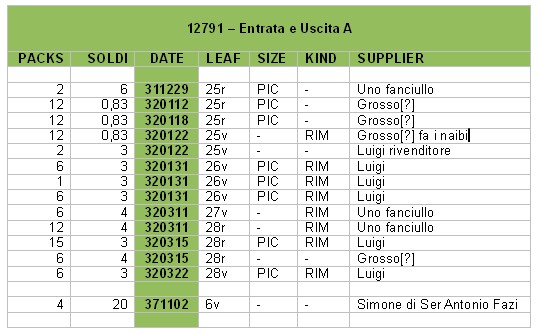http://trionfi.com/naibi-aquired
The "last entry" is from 2nd of November 1437 (371102 in Franco's notation), and it are recorded 4 decks with each a price of 20 soldi. They fall in the category "expensive decks (= 20 soldi or more), which are not called Trionfi decks, but might have been hidden Trionfi decks" (which are rare on the lists of the silk dealers).
The last entry corresponds to a purchase of four packs of naibi from Simone di Ser Antonio Fazi; his profession is not indicated, but we can assume him to be a cardmaker. It is unavoidable for us to connect him with Antonio di Simone, maybe his son, whom we find later on as a maker of expensive cards. Important is that we find here his family name too, and it has been possible to find him in Catasto 1427, the known series of books with much information on Florentine families.(8) I could read there that he was 33 and lived together with his wife, 25, and a third person; I was certain to find his child Antonio di Simone recorded together with his parents - unfortunately for us (and maybe for him) the third person of the family was instead by then... his mother-in-law.
An "Antonio Fazzi" with the occupation "notaio" is recorded at this entry ...
http://cds.library.brown.edu/projects/t ... Y%3D113467
... in the Tratte records in 1409, likely identical to "Ser Antonio Fazi", the father of Simone di Ser Antonio Fazi (the "Ser" indicates the profession "notaio").
Simone di Ser Antonio Fazi occurs, as Franco notes, in the catasto. The record is here ...
http://cds.library.brown.edu/projects/c ... D+50003459
He owns a house and the real estate is given with 405, from which 295 are taxable. So ... he isn't very rich and he's not poor in 1427. A trade is not indicated.
A "Simone di Antonio Fazzi" appears in 1436, 1438 and 1442 in the guild elections; guild 37 = Coreggiai, that means
harness-makers, saddlers and shield-makers, which is strange, if we consider him as a playing card producer. In 1436 he is elected. In the elections of 1438 and 1442 he gets the Rdraw code "43".
http://cds.library.brown.edu/projects/t ... +OFFICE%2C
According the code book ...
http://cds.library.brown.edu/projects/t ... ebook.html
... this means
"43=In "Speculo". This generally meant that the individual was in tax arrears and was thus not eligible for office, but it might also have had other as yet uncertain meanings."
So possibly he hadn't the best business around 1436-1438 ... which is the time, when he made the 4 decks.
Franco Patesi describes the (possible) son Antonio di Simone:
On the silk dealer lists Antonio di Simone appears first in 1442, between May and October.3.3 Antonio di Simone
Antonio di Simone is usually indicated as "fa i naibi", but among cards supplied by him we seldom find more than a dozen packs; usually he brings to the store a couple of packs, or a little more. On the other hand, his prices are remarkably higher than those of the other makers. We find surprising little variations around a unit price of 9s. In the course of time, this will be nearer to the common price of trionfi, than of naibi.
I suppose that the biggest difference with other products mainly (if not only) consisted in a more accurate decoration. These packs are seldom mentioned as fini, and never as gilded, but some justification should have existed for a price that was about the double than that of packs produced by Antonio di Dino, and five times the usual price for those of Niccolò di Calvello. Probably the indication of mezzani that we find in some cases should be extended to all these packs, because of the constant price; the same for doppi, whereas the fact that we find sometimes these packs mentioned as charte instead of naibi does not appear as a significant difference (still due to the same prices).
1442 ... 6 deals / 16 packs (between May and October)
If we conclude from the condition, that the catasto note for Simone di Ser Antonio Fazi reports, that Antonio di Simone wasn't mentioned, cause he wasn't born, then he would have been in 1442 only 15 or less years old.
If one would conclude, that he just lived outside of the household, then he might have been 0-10 years old, if we assume, that the wife of 147 was his real mother (she was 25 in 1427) and assume, that 15 is a sort of lowest age for a child (generally it's said, that in Florence girls did marry late usually).
A third possibility is, that the wife of 1427 had been second wife and that Antonio di Simone had been just a step son. Then Antonio di Simone might have been in 1427 c. 0-18 years old (the father was 33 in 1427).
The 4th possibility is, that he wasn't the son of Simone di Ser Antonio Fazi.
Normally the 1st possibility shown above should be most probable, but a 15 years old business man on own feet is curious. Possibly the father had died in the year 1442, so that he had to care for the family.

